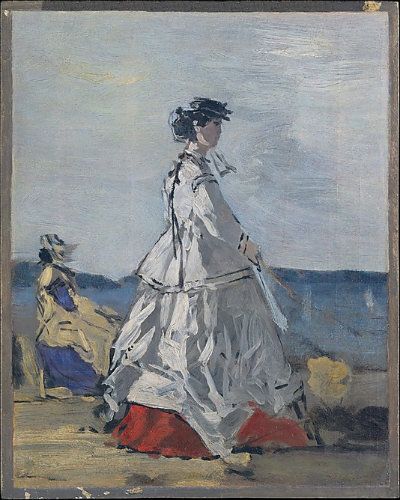Fabulous Fashionistas: Princess Pauline Metternich
10:54 AM
I first encountered Pauline Metternich when I was given an assignment in my 19th Century Fashion class last semester to pick a painting at The Metropolitan Museum of Art and write about it. My eye was caught, surprisingly enough, by a tiny impressionistic painting in the corner of one of the 19th Century European Art galleries. Little did I know that I was about to meet a woman who would become one of my favorite historic figures! I'll write more about her, because a short post couldn't possibly do her justice. If you would like to know more about Pauline, I highly recommend her memoirs, My Years in Paris. Until then, here's a little intro to Fabulous 19th Century Fashioista, Pauline Metternich! (I copied this post from the beginning of my paper, so you get some footnotes!)
Eugene Boudin, Princess Pauline Metternich on the Beach,
c. 1865-67. The Metropolitan Museum of Art, New York.
Pauline
Metternich (1836-1921)
was born to in Vienna to Count Mortiz Sandor, a Hungarian nobleman,
and Leontine von Metternich. Count Sandor was a famous horseman and, according
to his daughter, “daring to the point of recklessness, and altogether what is
best described as a ‘character’”.[1]
She married Prince Richard von Metternich, a diplomat, in 1856. In 1859, Prince
Metternich was “sent to France… in order to ratify some clause of the Treaty of
Zurich, which had been concluded when the war with Italy came to an end”,[2]
where his wife joined him. Prince Metternich was soon appointed Ambassador to
France, and the couple remained a fixture at the court of Napoleon III until
1870, when the Second Empire came crashing down.
Princess
Metternich had a strong personality. In the preface to her memoirs, The Days That Are No More: Some
Reminiscences (1921), Edward Legge writes that “she boasted of her father’s
peculiarities and found in them an excuse for her own oddities”.[3]
Legge continues, saying:
“She had not been among the
Parisians many months ere the more prudish discovered that they had among the
reputed grandes dames an Ambassadress
who did not scruple to behave, and not infrequently, like a grisette. She kissed Count Beust… at an
official reception at the Tuileries, to wheedle him into giving a fancy-dress
ball, and said impertinent things of the Empress who had impulsively taken the
eccentric Hungarian to her heart… I can give only an inkling of her
eccentricities, which were passed over by the Empress with a smile… It would
not have surprised anyone in the monde,
demimonde, or quart de monde to
have seen the Austrian Ambassadress jump on the table and dance the “can-can!”
She was quite equal to it.”[4]
Metternich
was known for her intelligence and wit, and maintained a close friendship with
the Empress Eugenie. The pages of another volume of her memoirs, My Years in Paris (1922), are full of
loving descriptions of the Empress, painting her as a kind and devoted friend. When
the Second Empire fell, it was Metternich whom the Empress trusted to smuggle
her jewels out of the country.[5]
Franz
Xaver Winterhalter, Princess Pauline de
Metternich, 1860. Location unknown
Metternich
was not known as a great beauty. Legge describes her as “slim” and “wiry”,[6]
and in My Years in Paris Metternich
often describes herself as “thin as a lath”.[7]
Yet she became one of the most important fashion figures during the Second
Empire, often referring to herself as “la
singe a la mode”—the fashionable monkey.[8]
She is credited with launching the career of Charles Frederick Worth, and
devotes an entire chapter of My Years in
Paris to describing the great couturier. She writes that “a conversation
with him amounted to a real pleasure. He had a rare insight into women—an
unerring instinct where they were concerned”.[9]
At first wary of an English dressmaker, Metternich was impressed by his fashion
sketches and commissioned two dresses, one of which was worn to a ball at the Salle des Marechaux at the Tuileries.[10]
She describes the sumptuous luxury of the gown:
“I wore my Worth dress, and can
say with truth that I have never seen a more beautiful gown, or one that fitted
me more beautifully. It was made of white tulle strewn with tiny silver discs
(a fashion which, just then, was at its height), and trimmed with crimson-hearted
daises that nestled among little tufts of feathery grass; these flowers were
all veiled in tulle. A broad white satin sash was folded round my waist. I wore
all my diamonds, and—Worth scored his fist success.”[11]
[1] Metternich, The Days That Are No More, 80
[2] Metternich, My Years in Paris, 7.
[3] Metternich, The Days That Are No More, 8.
[4] Metternich, The Days That Are No More, 9-11.
[5] Metternich, My Years in Paris, 199.
[6] Metternich, The Days That Are No More, 34.
[7] Metternich, My Years in Paris, 23, 220.
[8] Metternich, The Days That Are No More, 11.
[9] Metternich, My Years in Paris, 60.
[10] Metternich, My Years in Paris, 56-58.
[11] Metternich, My Years in Paris, 58.





1 comments